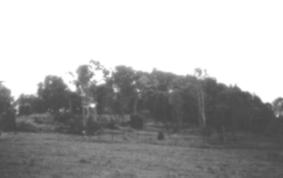
Australia’s only Megalithic site?
by Murray Byfield
The Gympie Pyramid is not really a Pyramid at all but a sandstone terraced hill on the outskirts of Gympie in Queensland Australia. Since its “discovery” in 1975 by amateur archaeologist Rex Gilroy, (locals had known about the site for years) many theories have been put forward as to who or what built it.
These theories range from Aliens, Atlanteans, Ancient Egyptian and Chinese sailors, Italian Winemakers, Swiss Horticulturists, to Polynesians.
Relics have been discovered in and around the “Pyramid” site including the stone “Gympie Ape” which some believe is the ape form of the Egyptian god Thoth, plus other unusual stone carvings including a crocodile and an Easter Island type head which some people use as evidence towards the ancient explorer hypothesis.
Archaeological surveys of the site have been conducted by several researchers many concluding that there is no evidence that the site was constructed by ancient explorers. And the most likely explanation is that the terraces were built by Italian wine growers.
According to local Aboriginal legend the Pyramid goes back centuries, but the local tribe makes no claim to it.
It has even been suggested the pyramid was a place to be avoided according to Aboriginal lore.
Archaeologist Greg Jeffery’s conducted a preliminary study of the site rejects such simple explanations. One of which simply being that no Italian families lived in the area at the time the Pyramid was originally discovered. He further points to why go to all the effort of terracing a hill when suitable flat fertile agricultural land was readily available. He also notes the majority of terracing appears on the southeastern slope. Ideally the northern slope would be the best aspect for agriculture.
Jeffery’s points to a possible Polynesian origin to the pyramid mystery, as the seafaring Polynesian race had the ability to reach Australia easily.
“The Polynesians certainly has a tradition of terracing hills in the construction of forts and for religious purposes (Bellwood 1978) and many examples of these are found throughout Polynesia. The god mounds of Tonga and the village fortresses of Rapaiti being just two examples. The stone wall structures on Rapaiti (Heyadahl 1958) bear quite a strong resemblance to the Gympie terraces.”
“Access to the area from the ocean would have been relatively easy via the Mary River although it is difficult to see why a people would travel so far upriver, particularly if they were of seafaring tradition.
The site is well located for a fortress commanding extensive and uninterrupted views of the surrounding flat terrain. The slopes are steep and easily defended. The unusual shapes boulders on the summit could easily be adapted to make excellent parapets. A permanent source of fresh water is available from a spring on the southwest slope and fertile flat land watered by a substantial permanent creek exists in abundance at the base of the ‘pyramid’ to the east and south.
The discovery of an Oceanic styled statue in a field nearby may lend support to this hypothesis.”
Local researcher Brett Green has dedicated countless hours trying to get to the bottom of the Pyramid mystery. His thoroughly researched CD ROM documents all of his findings, including debunking some of his own previous discoveries.
Today the Pyramid site is a shadow of its former self. During the media frenzy of the 70’s wannabe archaeologists and treasure hunters ruined many of the terraces in search for relics. One relic hunter even took to the site with a bulldozer.
The Dhamurian Society are the current caretakers of the pyramid site and have commenced reconstruction of some the terraces. Unfortunately, the Gympie Pyramid site is currently under threat of being destroyed due to possible land development and road construction.
Despite the various conclusions of several Archaeologists, the jury is still out on the Gympie Pyramid Mystery.
Sources:
http://www.stradbrokeislandgalleon.com/Gympie.html
http://www.gympiepyramid.org

